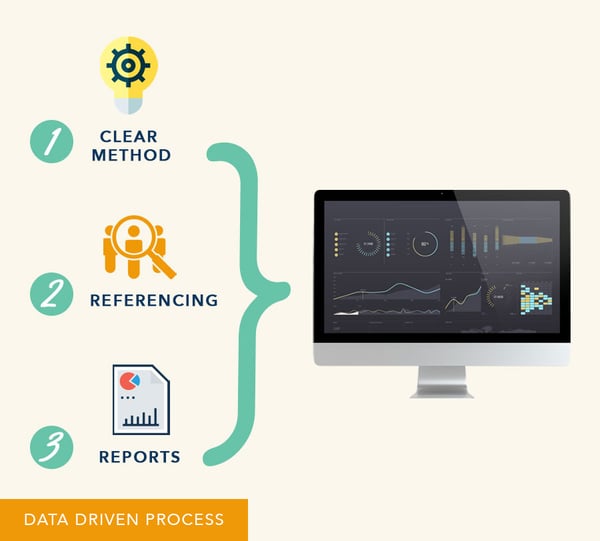Some of the conventional wisdom in sourcing and recruiting includes an exclusivity on “personal” interaction. That is, filling a position in a company must necessarily be driven by interpersonal assessments of the candidate and their application documents, as if they were a book to be read. But jobs, candidates, and hiring are much more complex than we often think. That’s why more HR operations are looking to data-driven business tools to help them source candidates.
Here, we’ll briefly discuss what it means to use data to hire a candidate, and why you should use business intelligence not only to hire, but to rethink how you approach HR and candidate sourcing.
Sourcing and the Black Box Approach

Data is all about transparency, however, and this isn’t the typical way that most recruiting firms have done their work. I worked with a recruiting firm that hired for some of the largest companies in the world. I don’t say that to brag, only to stress that when we hired candidates, we did so with the understanding that we needed the best, and we needed to be the best in representing the brands we recruited for.
I worked with a partner that consistently outperformed me. He found more candidates, he found better candidates, and his leads ended with more hires. One day I asked him what his approach was.
This is what he told me:
"Recruiting is like a black box. You don't know what goes in and you don't know what comes out."
What he was doing, however, was to demystify this process for himself and for his clients.
First, he stopped leaning on “intuition-based” sourcing. Instead, he started developing some basic data metrics to help him track qualified job candidates.
Second, he worked closely with his clients so that they knew what he was doing and (maybe even more importantly) how he was doing it. That way, they could provide insight into the types of candidates they were seeing, and how expectations might change over time.
The field of HR and recruiting has functions, for the longest time, on a certain opacity in hiring. We don’t keep clients informed, we don’t share our processes with them, and we certainly don’t update them in real time. We simply put the candidates in front of them and hope for the best.
This is “intuition”, the black box, because you don’t know what goes on in there. You ask for a candidate, something happens, and then out pops a handful of interviews.
Data, when used properly, can break us out of that model. When we use data, we can transparently outline our sourcing process from start to finish. While this can help recruiters improve these processes, it also provides companies hiring said recruiters to know what is and isn’t happening in the recruitment process.
What is Data-Driven Business?

“Data driven” has become one of those buzzwords that we think we understand, but really becomes meaningless over time. Marketers and so-called influencers in science and tech like to use the term without grounding the term in any context that could drive innovation.
For example, you might hear companies describe themselves as “data driven” without explaining how they use data to drive anything relevant to their business. Likewise, these same companies might use the term “big data” to sell their products when they do anything but work with big data analysis.
When we describe a process as “data-driven”, we have a few concrete reasons for doing so:
- That process has a clear methodology for data collection that includes the reason for collecting that data, the work to do on that data, and what kind of intelligence that data can provide.
- That process includes methods for linking, referencing, and querying data in a meaningful way.
- Reports, including clear and concise visual reporting, must emerge naturally from those queries so that relationships within the data are clear even to non-specialists.
Most importantly, data-driven processes allow experts to provide real analysis and advice based on that data. Using data to provide insight is perhaps the most important aspect of any data-driven endeavor.
Data and Recruiting: Using Intelligence to Nurture Candidates

With that being said, it may seem unintuitive to use data to drive such a human-centric task such as recruiting. As a paper in Trends in Cognitive Science notes, however, data-driven methods help to relax the constraints of cultural biases in scientific inquiry.
Yes, we are describing candidate sourcing as a scientific process. No, we aren’t completely full of ourselves.
Analytics, developed by a competent researcher with an understanding of HR, recruiting, and candidate sourcing can help a company develop a “snapshot” of how their hiring process does or does not attract candidates.
Furthermore, using data during the recruitment process lets us, and our clients, plug into the human elements of recruiting… namely, how real candidates respond. A broken or dysfunctional process will become evident under scrutiny.
Likewise, an analytical approach to recruiting and HR provides a pathway for candidate recruitment. Data helps sourcing firms like ours develop a pool of real candidates without all the fluff. Since high-quality candidates have already been identified, it’s more worthwhile to mobilize a nurture campaign to help put these candidates in front of a hiring committee.
Recruiting Without Data Means Using the Same Tools and Expecting Different Results

This doesn’t mean that data is the complete solution to all recruiting issues. It does mean that you can rely less on the “gut feeling” aspect of hiring that often ends up with an underperforming hire and an unhappy company.
A great example of this is the film Moneyball. This film tells the story of Billy Beane (played by Brad Pitt), who stepped in to manage the Oakland A’s during the 2002 season. The A’s face a poor season in which major franchise players leave for more money with other baseball clubs, and replacing those players is nearly impossible due to a limited budget.
Skip story >>
Beane faced a difficult situation: traditional baseball recruiting suggested that he tries to fit traditional roles by reaching out to highly-ranked (and expensive) players. This advice, pushed by Beane’s group of coaches and recruiters, focused on watching game tape, assessing players visually, and a lot of intuition on how players would perform.
In the movie, Beane decided to work with a Yale economics graduate named Peter Brand (based off a real person of a different name) to try and understand the problem from a different angle. Brand, using sabermetrics and data-driven modelling, suggested recruiting players based on their on-base percentage rather than the traditional metrics that recruiters used.
As it turned out, this strategy allowed Beane to recruit players that no one else wanted at discount prices.
That year, the A’s went from one of the worst teams in the league to the Division championship. Despite decades of experience in recruiting, Brand’s data-driven model was able to produce a championship-caliber team from literally nothing.
This example is meant to illustrate how established methods of doing something can lead to stagnation and painful, unproductive struggles. Data, however, can pull the blinders away from our eyes and show us ways to improve our game.
This is something that we have seen in recruiting. Some classics include:
- If a field of suitable candidates exists, and that this field is readily available through traditional HR channels.
- That experience in a job, or experience in HR, is objective enough to understand how a candidate might fit with a team.
- That HR can eliminate biases in terms of demographics, industry, or work styles.
- That candidates will jump through hoops for any job, and that these candidates don’t need active, nurturing recruitment.
Building Your Analytics Model: Extending your HR

Including a data-driven initiative in your HR operation can sound daunting to say the least. However, it isn’t the case that you need to completely reconfigure your HR from scratch just to find great candidates.
One of the most flexible solutions is to find an agency that focuses on HR audits and consultations. Data-driven companies can provide serious value to your HR by “bolting” onto your existing sourcing team and providing immediate insight on how effective your candidate searches really are.
Using data for your candidate searches isn’t a brand-new idea… but it is an idea that’s still finding its footing. Sometimes the best solution is to find an organization committed to HR analytics and data-driven sourcing that can also help you assess how effective your recruiting efforts actually are.

References
Jaffe, Eric. “What Big Data Means for Psychological Science”, Association for Psychological Science, psychologicalscience.org July 22 2014, https://www.psychologicalscience.org/observer/what-big-data-means-for-psychological-science.
Jack, Rachael E., Crivelli, Carlos, and Wheatley, Thalia. “Data-Driven Methods to Diversify Knowledge of Human Psychology”, Trends in Cognitive Sciences 22, no. 1 (2018), https://www.sciencedirect.com/science/article/pii/S136466131730222X.
King, Kylie Goodell. “Data Analytics in Human Resources: A Case Study and Critical Review”, Human Resource Development Review 15, no. 4 (2016), https://journals.sagepub.com/doi/abs/10.1177/1534484316675818?journalCode=hrda.
Peregud, Irina. “Five Characteristics of a Data-Driven Company”, Transforming Data with Intelligence, tdwi.org, September 26, 2018, https://tdwi.org/articles/2018/09/26/ppm-all-five-characteristics-data-driven-company.aspx.








